2.09.2025

Mit freundlicher Zurverfügungstellung von Diego Cuoghi
ART and UFOs? No thanks, only art...
KUNST und UFOs? Nein danke, nur Kunst …
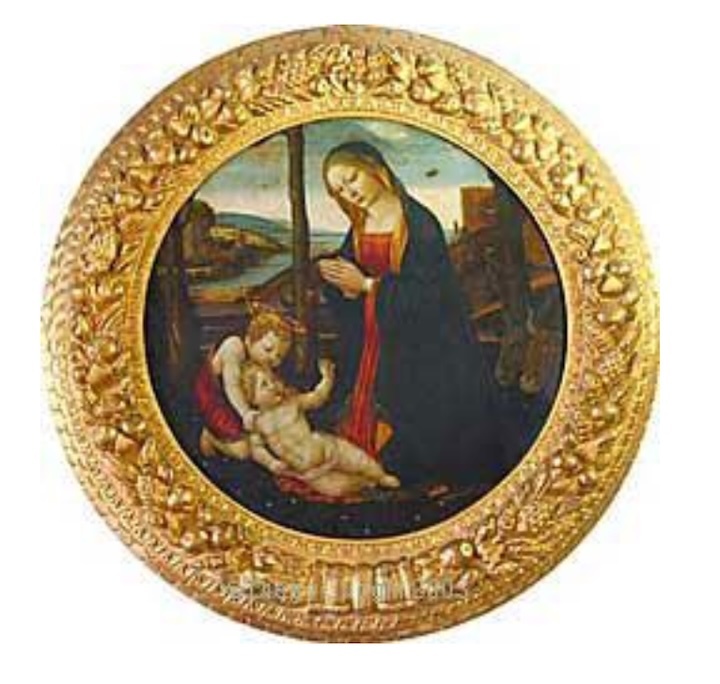
“Meanwhile the average man had become progressively less able to recognize the subjects or
understand the meaning of the works of art of the past. Fewer people had read the classics of
Greek and Roman literature, and relatively few people read the Bible with the same diligence that
their parents had done. It comes as a shock to an elderly man to find how many biblical references
have become completely incomprehensible to the present generation.”
Kenneth Clark
( introduction to"Dictionary of subjects and symbols in Art" by James Hall)
Inzwischen war der Durchschnittsmensch immer weniger in der Lage, die Motive zu erkennen oder die Bedeutung der Kunstwerke der Vergangenheit zu verstehen. Immer weniger Menschen hatten die Klassiker der griechischen und römischen Literatur gelesen, und nur wenige lasen die Bibel mit der gleichen Sorgfalt wie ihre Eltern. Für einen älteren Mann ist es ein Schock, festzustellen, wie viele biblische Bezüge für die heutige Generation völlig unverständlich geworden sind.
Kenneth Clark
(Einleitung zu „Dictionary of Subjects and Symbols in Art“ von James Hall)
+
As widely known, the acronym U.F.O. stands for “Unidentified Flying Object”.
Obviously once a Flying Object is identified, it cannot be considered a UFO anymore. These pages deal with a series of Flying Objects which, as some people say, appear into ancient works of art. As a matter of fact many books, and above all many web sites dealing with paleo-astronautic or clipeology, present various works of art as an evidence of UFO sightings in the past. Unfortunately, once seriously considered, these same works of art prove to be much more related to art itself than to any UFO concern.
The following web sites are just few of the many that deal with the subject:
Wie allgemein bekannt, steht das Akronym UFO für „Unidentifiziertes Flugobjekt“.
Sobald ein Flugobjekt identifiziert ist, kann es natürlich nicht mehr als UFO betrachtet werden. Diese Seiten befassen sich mit einer Reihe von Flugobjekten, die, wie manche behaupten, in antiken Kunstwerken auftauchen. Tatsächlich präsentieren viele Bücher und vor allem viele Webseiten, die sich mit Paläo-Astronautik oder Clipeologie beschäftigen, verschiedene Kunstwerke als Beweis für UFO-Sichtungen in der Vergangenheit. Leider erweisen sich diese Kunstwerke bei genauerer Betrachtung als viel mehr mit Kunst selbst als mit UFO-Sichtungen verbunden.
+
"ESALTATION OF THE EUCARISTY" (Detail of the Trinity) by
Ventura Salimbeni
Church of San Pietro, Montalcino
„Erhöhung der Eucharistie“ (Detail der Dreifaltigkeit) von
Ventura Salimbeni
Kirche San Pietro, Montalcino
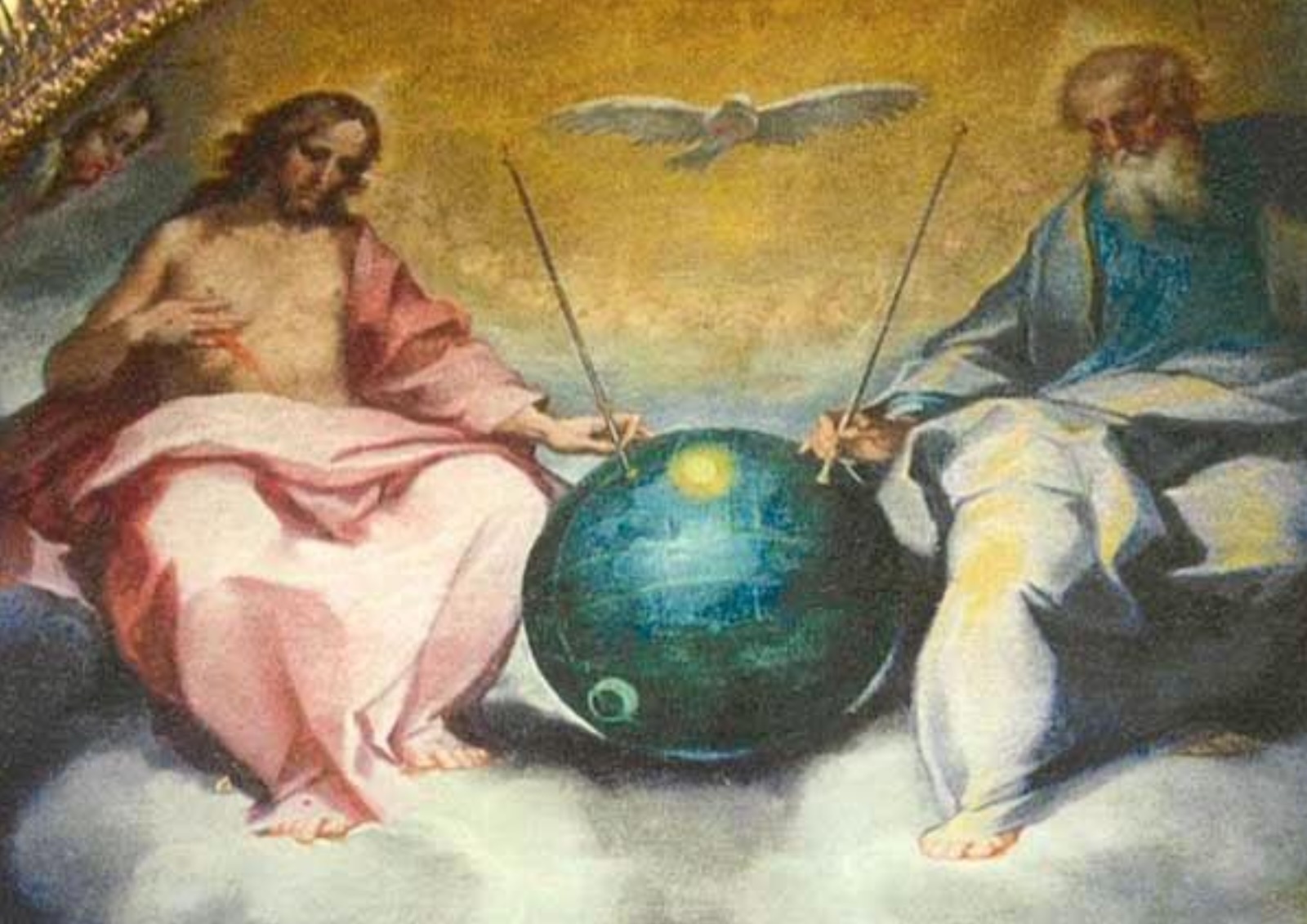
+
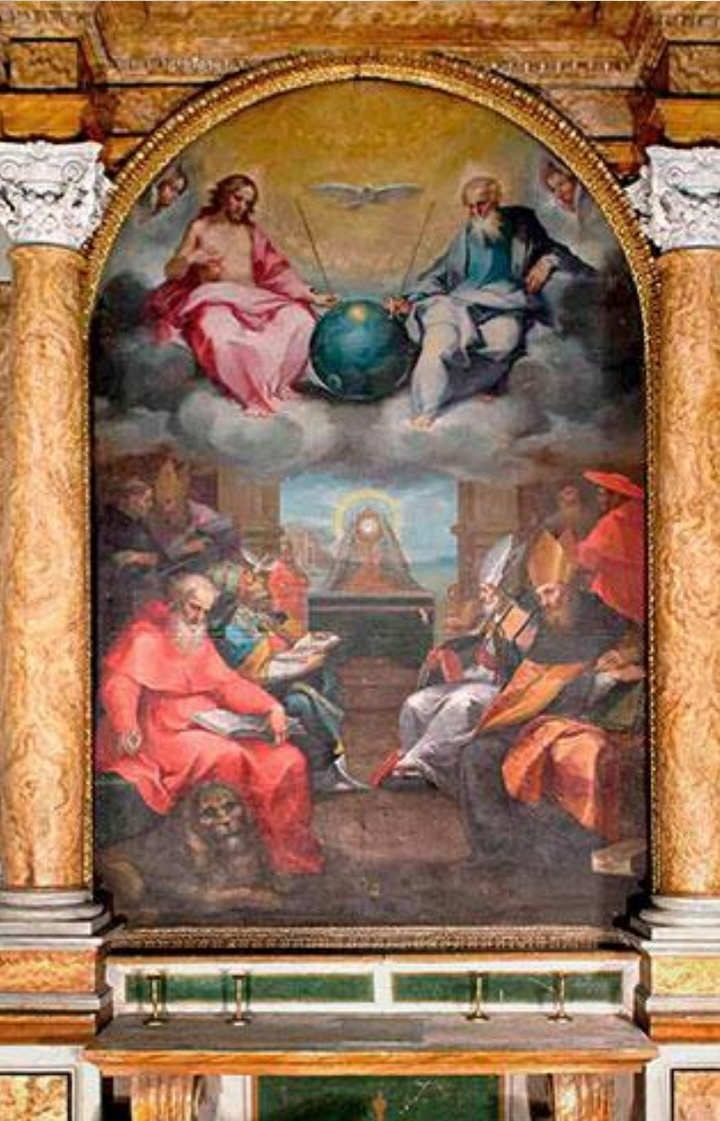
Finally there is the controvert discussion about the so called UFO or “Sputnik” of Montalcino. This is actually the name so often used by certain sites to refer to the object represented in the church of St. Peter in Montalcino, painted at the end of XVI century by Ventura (or Bonaventura) Salimbeni. The pages of Edicolaweb for example reads: “it recalls indeed the Russian artificial satellites”. It is worth to mention that hypothesis of this kind lost strength after the publishing of the article by Samuele Ghilardi, Amos Migliavacca and Elenio Salmistraro: “The Satellite of Montalcino”.
Schließlich gibt es noch die kontroverse Diskussion über das sogenannte UFO oder den „Sputnik“ von Montalcino. Dieser Name wird häufig von bestimmten Websites für das Objekt verwendet, das in der Kirche St. Peter in Montalcino abgebildet ist und Ende des 16. Jahrhunderts von Ventura (oder Bonaventura) Salimbeni gemalt wurde. Auf den Seiten von Edicolaweb heißt es beispielsweise: „Es erinnert tatsächlich an die künstlichen russischen Satelliten.“ Es ist erwähnenswert, dass diese Hypothese nach der Veröffentlichung des Artikels „Der Satellit von Montalcino“ von Samuele Ghilardi, Amos Migliavacca und Elenio Salmistraro an Bedeutung verlor.
The authors describe how the painting has been analyzed by means of photographs taken from short distance and declare to agree with Ion Hobana, who states:
«It's very interesting the interpretation of Ion Hobana, great expert of UFOs and author of the optimal volume " Enigme pe cerul istoriei ". He said the object would be an ancient map of the world, representative the Creation, in
which the sun is visible and a primitive shape of marking of the meridians and parallels; moreover the small cylinder would be the hinge for being able to fix to a support the sphere. An example is visible in Vatican. From the analyses carried out on the photographies and the painting originates them cannot be gained elements that make to suppose a ufologico event, while they have been finds numerous points to you in common with Greek-orthodox religious raffigurazioni. In many icons coming from from the East it is possible to notice spheres with the same symbols and tracings, accompanied or from the single figure of the Christ or from all the Trinity.»
Die Autoren beschreiben, wie das Gemälde anhand von aus kurzer Entfernung aufgenommenen Fotografien analysiert wurde, und stimmen mit Ion Hobanas Aussage überein:
„Die Interpretation von Ion Hobana, einem großen UFO-Experten und Autor des Werks „Enigme pe cerul istoriei“, ist äußerst interessant. Er sagte, das Objekt sei eine antike Weltkarte, die die Schöpfung abbilde, auf der die Sonne und eine primitive Form zur Markierung der Meridiane und Breitengrade zu sehen seien; der kleine Zylinder diene zudem als Scharnier zur Befestigung der Kugel an einer Halterung. Ein Beispiel dafür ist im Vatikan zu sehen. Aus den Analysen der Fotografien und des Gemäldes lassen sich keine Elemente ableiten, die auf ein ufologisches Ereignis schließen lassen, obwohl zahlreiche Gemeinsamkeiten mit griechisch-orthodoxen religiösen Darstellungen gefunden wurden. Auf vielen Ikonen aus dem Osten sind Kugeln mit denselben Symbolen und Umrissen zu erkennen, begleitet entweder von der einzelnen Christusfigur oder von der gesamten Dreifaltigkeit.“
Even this painting proves to be at least not so different from any other of the same gender. Indeed all paintings in which the Trinity is represented show Jesus, the Father and the Holy Spirit in the shape of a dove. Usually even the “Creation Globe” or "Celestial Sphere" is presented, symbolizing not simply the Earth bu the universe as a whole. In addition many paintings present also the “wands” hold by Jesus and the Father, which are frequently described as the antennas of the sputnik. The first two are "The Adoration of the Holy Trinity" (1640) by Johann Heinrich Schonfeld and " La Messe de Fondation de l'order des Trinitaires" (1666) by Juan Carreno De Miranda. Both the paintings are displayed at theLouvre Museum, Paris.
Sogar dieses Gemälde unterscheidet sich zumindest nicht so sehr von anderen desselben Genres. Tatsächlich zeigen alle Gemälde, in denen die Dreifaltigkeit dargestellt wird, Jesus, den Vater und den Heiligen Geist in der Gestalt einer Taube. Normalerweise wird sogar der „Schöpfungsglobus“ oder die „Himmelskugel“ dargestellt, die nicht nur die Erde, sondern das Universum als Ganzes symbolisiert. Darüber hinaus zeigen viele Gemälde auch die „Stäbe“, die Jesus und der Vater halten und die oft als Antennen des Sputniks beschrieben werden. Die ersten beiden sind „Die Anbetung der Heiligen Dreifaltigkeit“ (1640) von Johann Heinrich Schönfeld und „La Messe de Fondation de l'order des Trinitaires“ (1666) von Juan Carreno De Miranda. Beide Gemälde sind im Louvre in Paris ausgestellt.
+

+
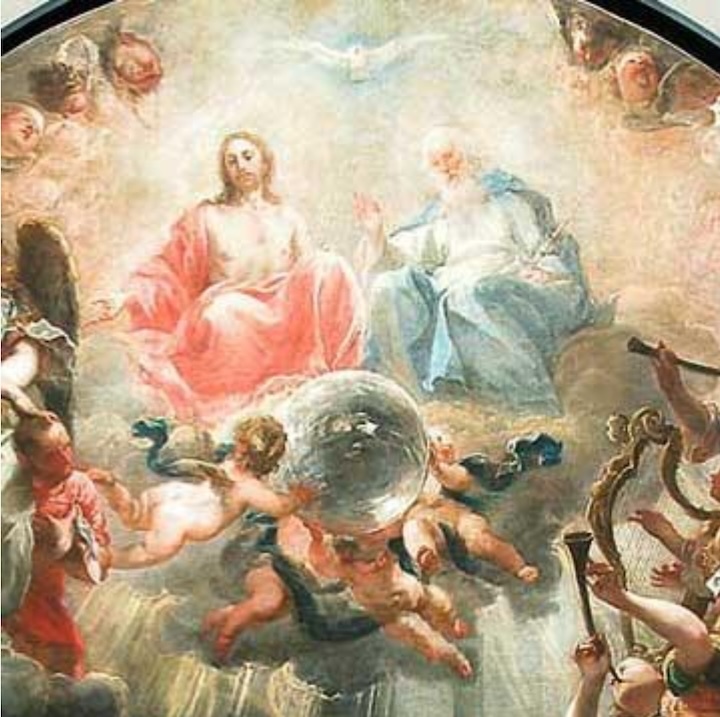
+
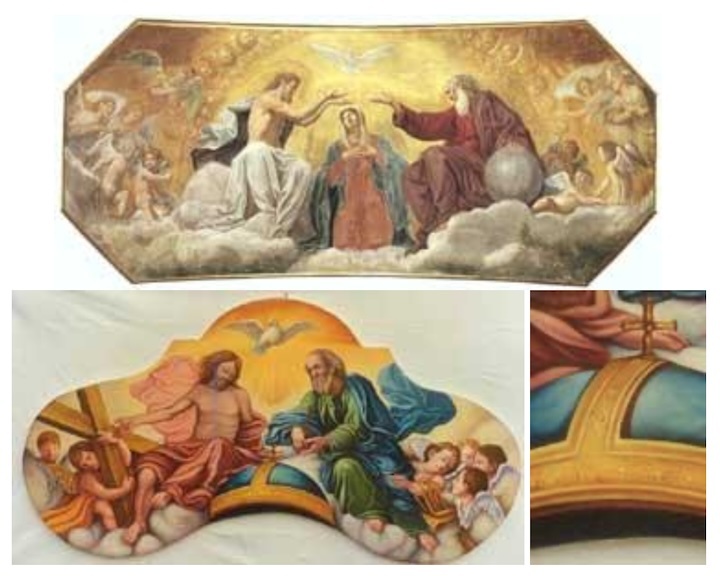
+
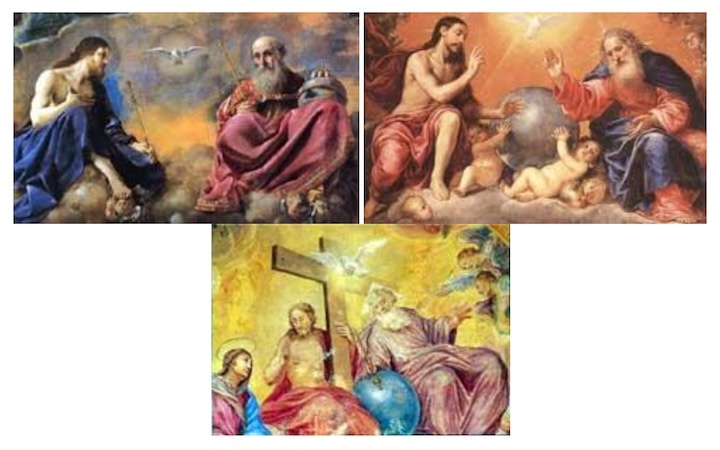
+
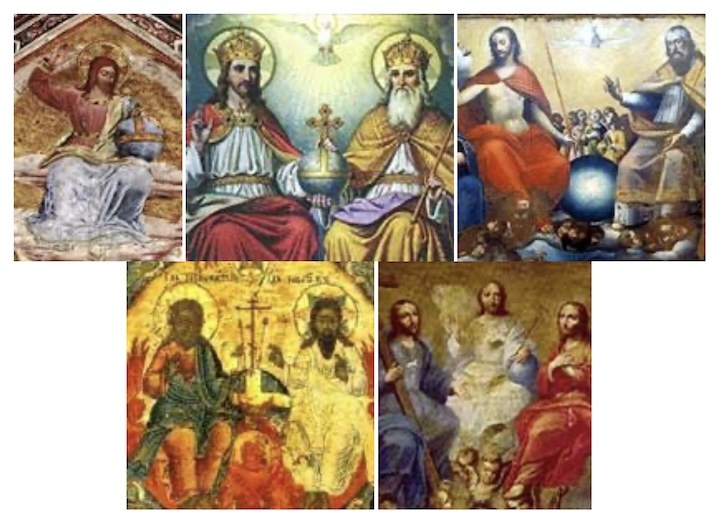
+
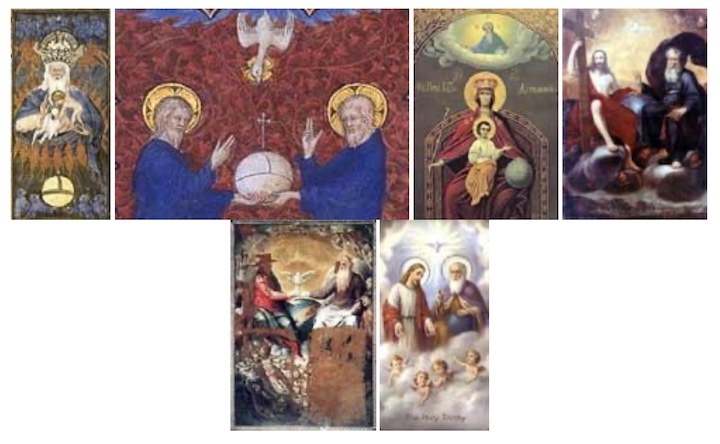
What is considered most strange in the globe of the Montalcino painting is the detail visible at the bottom, close to Jesus feet, which many authors describe as a “periscope”. The rumen ufologiest Ion Hobana finds it similar to the central pivot used in certain globes and reports of a specific one which, according to him, could be seen in the Vatican. Despite this the detail at issue is neither a periscope nor a pivot. Clearly visible on the sphere are instead the Sun an the Moon (respectively at the top middle and at the bottom left) together with the lines which form the reverted T also present in other examples.
Das Merkwürdigste am Globus des Montalcino-Gemäldes ist das unten, nahe den Füßen Jesu, sichtbare Detail, das viele Autoren als „Periskop“ beschreiben. Der Pansenufologe Ion Hobana findet darin Ähnlichkeiten mit dem zentralen Drehpunkt bestimmter Globen und berichtet von einem bestimmten, der seiner Aussage nach im Vatikan zu sehen war. Trotzdem handelt es sich bei dem betreffenden Detail weder um ein Periskop noch um einen Drehpunkt. Deutlich erkennbar sind auf der Kugel stattdessen Sonne und Mond (oben in der Mitte bzw. unten links) sowie die Linien, die das umgekehrte T bilden, das auch in anderen Beispielen vorhanden ist.
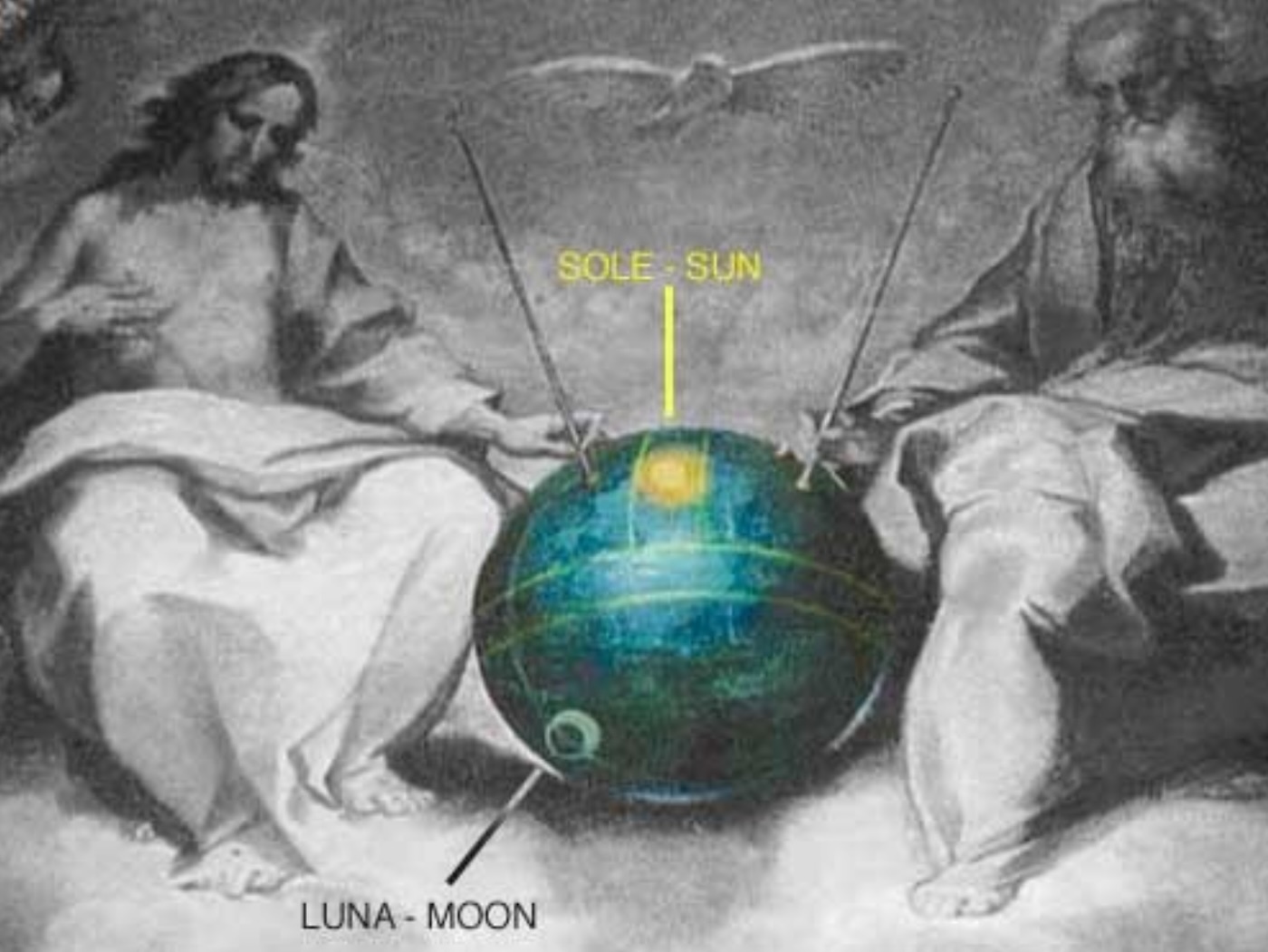
The same kind of astronomic representation into the sphere is present in another painting, by Pieter Coecke, illustrating the Trinity.
Dieselbe Art der astronomischen Darstellung in der Kugel findet sich in einem anderen Gemälde von Pieter Coecke, das die Dreifaltigkeit darstellt.
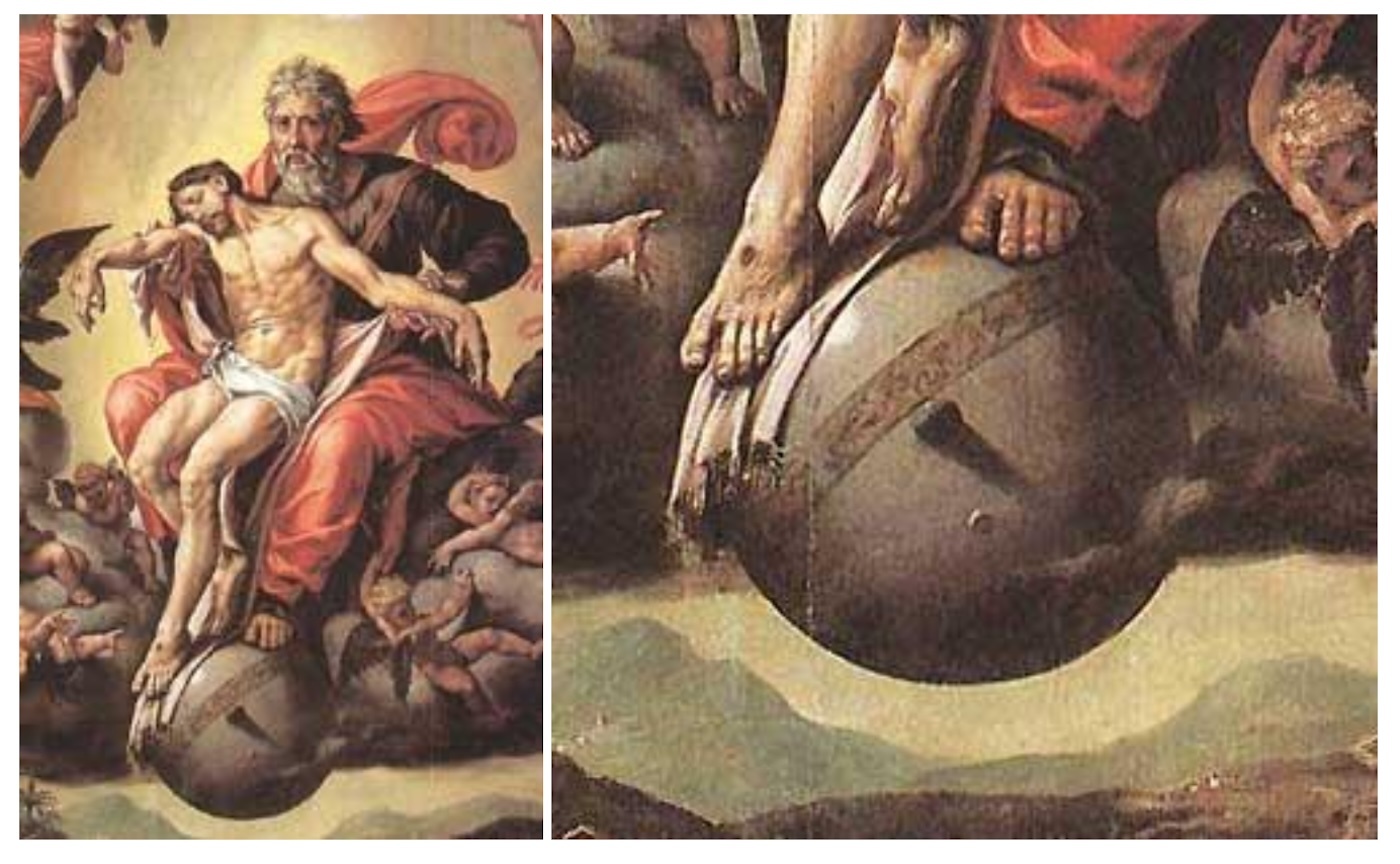
Maybe the bigger Celestial Sphere is a sculpture by Giacomo Colombo in the Trinity Church of Popoli (cm.130 x 100 x h165), and the smallest is in the hands of Jesus and Mary in a painting of Tommaso di Stefano Lunetti, where the
Celestial Sphere is very similar to the one painted by Salimbeni.
Möglicherweise handelt es sich bei der größeren Himmelskugel um eine Skulptur von Giacomo Colombo in der Dreifaltigkeitskirche von Popoli (130 x 100 x 165 cm), und die kleinere befindet sich in den Händen von Jesus und Maria auf einem Gemälde von Tommaso di Stefano Lunetti, wo die Himmelskugel der von Salimbeni gemalten sehr ähnlich ist.
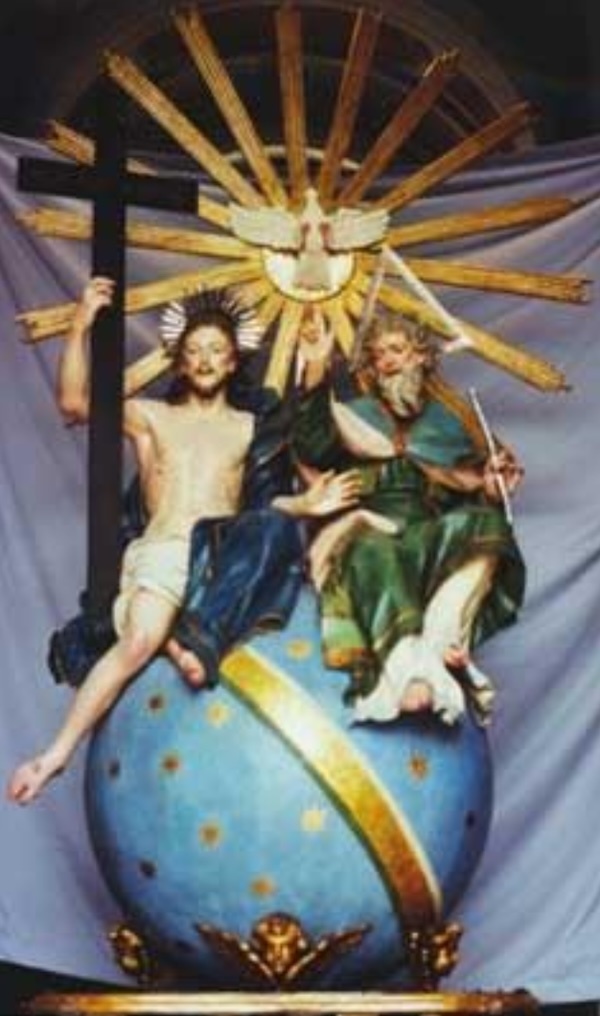
+
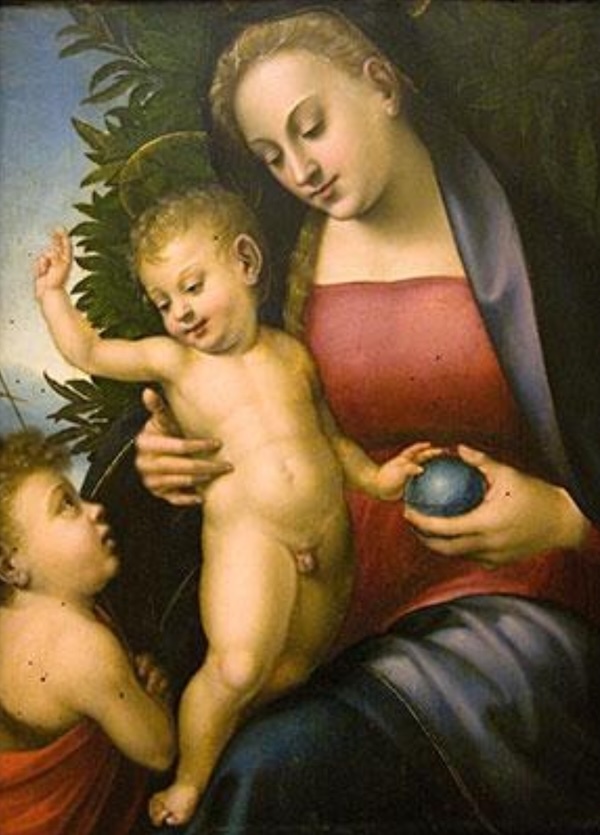
+
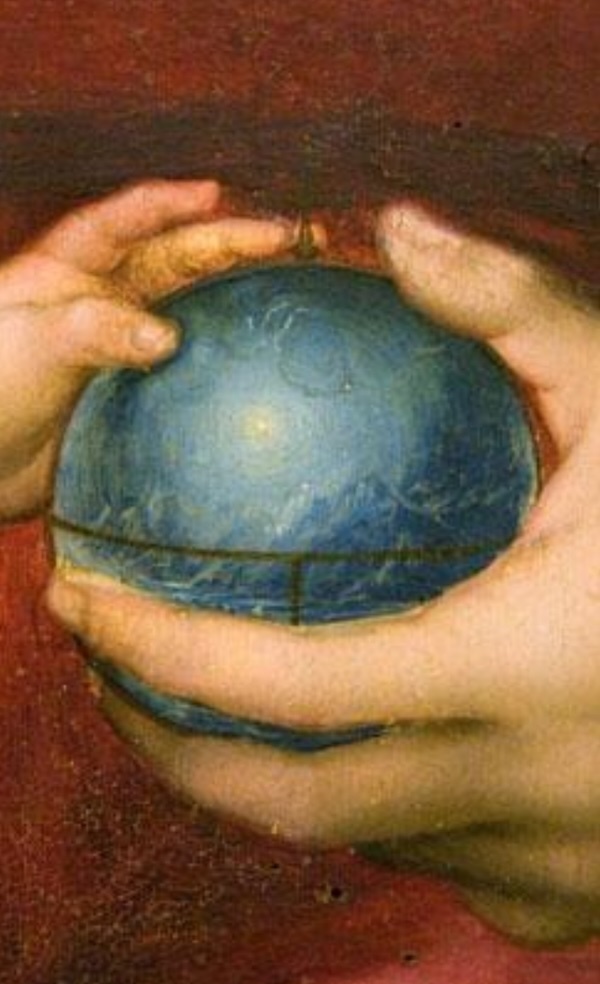
Focusing on the sphere, anyone can see the Zodiac, the Sun, the Earth with its shadowing cone and the Moon, very small at the bottom. It's a representation of the Sphaera Mundi, with the Earth at the centre of the Universe, held by God's hand.
Wenn man die Kugel betrachtet, erkennt man den Tierkreis, die Sonne, die Erde mit ihrem Schattenkegel und den Mond, der ganz klein unten steht. Es handelt sich um eine Darstellung der Sphaera Mundi, mit der Erde im Zentrum des Universums, gehalten von Gottes Hand.
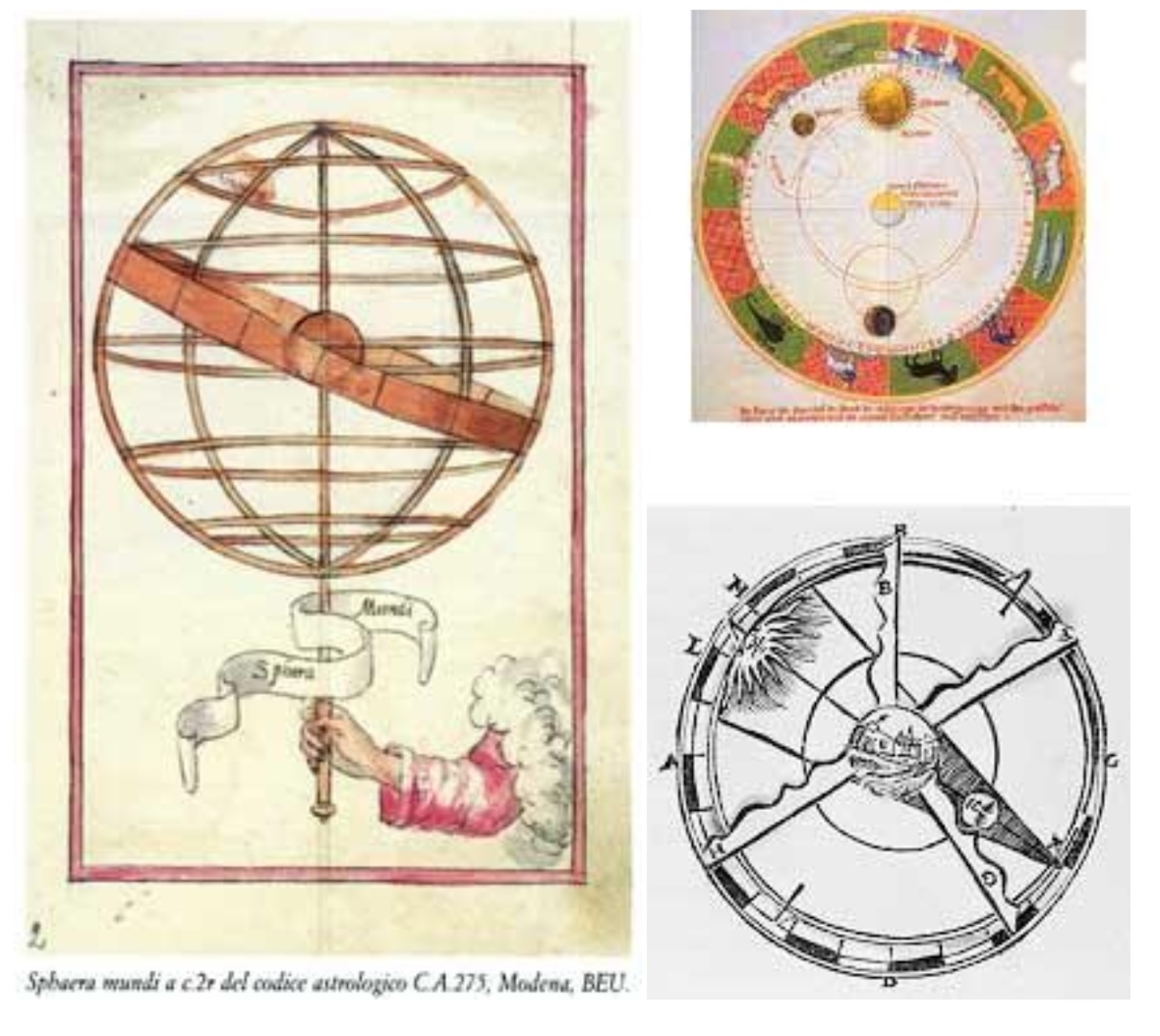
+
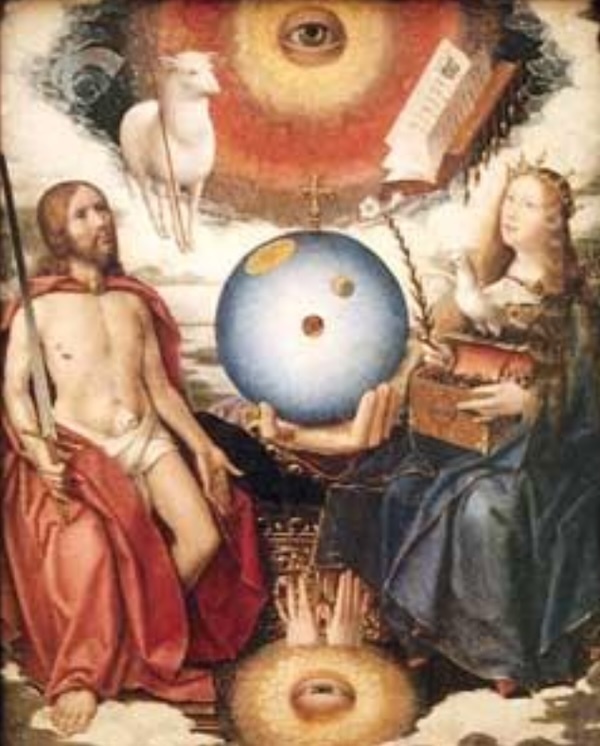
Another representation of the Celestial Sphere in a painting by Jan Provost titled "Christian Allegory" (Paris, Louvre).
In this illustration, taken from Minerva Britanna by Henry Peacham, at the centre of the sphere we do not see the Earth but the Human Being, and around him the Sun, the Moon an the Stars.
Eine weitere Darstellung der Himmelssphäre in einem Gemälde von Jan Provost mit dem Titel „Christliche Allegorie“ (Paris, Louvre).
In dieser Illustration aus „Minerva Britanna“ von Henry Peacham sehen wir im Zentrum der Kugel nicht die Erde, sondern den Menschen und um ihn herum Sonne, Mond und Sterne.
+
Conclusions
The sphere between the figures of the Holy Trinity in the "Esaltation of the Eucaristy" by Salimbeni, is not an UFO. That object, painted in many Trinity representations, is a symbol of the "Celestial Sphere", and in this particular
painting contains the illustration of the Sun and the Moon.
Schlussfolgerungen
Die Kugel zwischen den Figuren der Heiligen Dreifaltigkeit in Salimbenis „Erhöhung der Eucharistie“ ist kein UFO. Dieses Objekt, das in vielen Dreifaltigkeitsdarstellungen gemalt ist, ist ein Symbol der „Himmelssphäre“ und enthält in diesem speziellen Gemälde die Darstellung von Sonne und Mond.
Quelle:
